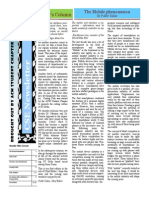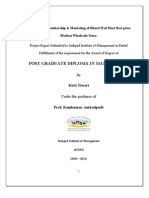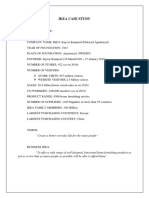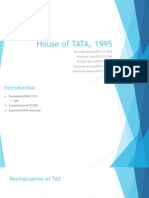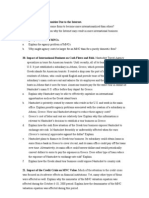0 ratings0% found this document useful (0 votes)
56 viewsAavas Financiers
Aavas Financiers
Uploaded by
Sirish GopalanAavas Financiers primarily serves low and middle-income self-employed customers in rural and semi-urban areas of 11 states in India. It offers home loans averaging INR 9 lakh in size. Strengths include its distinguished model focusing on underserved customers and scalable franchise. Weaknesses include ownership by private equity firms and geographical concentration. Opportunities exist in low housing penetration and government support, while threats include refinancing risks and retaining talent during growth. Aavas has demonstrated improving profitability through declining costs and a diversified funding mix.
Copyright:
© All Rights Reserved
Available Formats
Download as PPTX, PDF, TXT or read online from Scribd
Aavas Financiers
Aavas Financiers
Uploaded by
Sirish Gopalan0 ratings0% found this document useful (0 votes)
56 views8 pagesAavas Financiers primarily serves low and middle-income self-employed customers in rural and semi-urban areas of 11 states in India. It offers home loans averaging INR 9 lakh in size. Strengths include its distinguished model focusing on underserved customers and scalable franchise. Weaknesses include ownership by private equity firms and geographical concentration. Opportunities exist in low housing penetration and government support, while threats include refinancing risks and retaining talent during growth. Aavas has demonstrated improving profitability through declining costs and a diversified funding mix.
Original Description:
Avaas Financiers
Copyright
© © All Rights Reserved
Available Formats
PPTX, PDF, TXT or read online from Scribd
Share this document
Did you find this document useful?
Is this content inappropriate?
Aavas Financiers primarily serves low and middle-income self-employed customers in rural and semi-urban areas of 11 states in India. It offers home loans averaging INR 9 lakh in size. Strengths include its distinguished model focusing on underserved customers and scalable franchise. Weaknesses include ownership by private equity firms and geographical concentration. Opportunities exist in low housing penetration and government support, while threats include refinancing risks and retaining talent during growth. Aavas has demonstrated improving profitability through declining costs and a diversified funding mix.
Copyright:
© All Rights Reserved
Available Formats
Download as PPTX, PDF, TXT or read online from Scribd
Download as pptx, pdf, or txt
0 ratings0% found this document useful (0 votes)
56 views8 pagesAavas Financiers
Aavas Financiers
Uploaded by
Sirish GopalanAavas Financiers primarily serves low and middle-income self-employed customers in rural and semi-urban areas of 11 states in India. It offers home loans averaging INR 9 lakh in size. Strengths include its distinguished model focusing on underserved customers and scalable franchise. Weaknesses include ownership by private equity firms and geographical concentration. Opportunities exist in low housing penetration and government support, while threats include refinancing risks and retaining talent during growth. Aavas has demonstrated improving profitability through declining costs and a diversified funding mix.
Copyright:
© All Rights Reserved
Available Formats
Download as PPTX, PDF, TXT or read online from Scribd
Download as pptx, pdf, or txt
You are on page 1of 8
Aavas Financiers
About the company
incorporated as a retail affordable Housing Finance Company
primarily serves low/middle-income self-employed customers (~61%) in semiurban/rural areas.
Target customers are owners of grocery shops, beauty parlors, tiffin services, 3Ws, agriculture-
related businesses etc.
Product offering consists of home loans (~73% as of 3QFY21) for purchase, construction,
extension and repair of existing units
Average Ticket size of around INR 9 Lakh
present in 11 states covering Rajasthan, Maharashtra, Gujrat, Madhya Pradesh, Haryana, Uttar
Pradesh, Chhattisgarh, Delhi, Uttarakhand, Himachal Pradesh and Punjab.
Rajasthan, Gujrat, MP and Maharashtra account for 88% of total AUM
Swot Analysis
Strengths:
Distinguished model enabling growth longevity
primarily lends to self-employed (~61%) customers in the semi-urban/rural geographies; typically >50km
away from city center this ensures growth longevity and pricing power.
Deep reach, reducing borrowing cost and knowledge of local geography
Scalable franchise
Scalability depends on niche positioning, technology-backed processes and people
Best-in-class management execution and ability to hit above its weight (industry leading risk & data
analytics)
Appetite to grow
comfortably capitalized with tier-1 ratio of 51% (Dec’20) vs regulatory requirement of 10%. Low leverage
(~3.9x) and sturdy internal accruals
Sufficient capital buffer provides cushion for absorbing any unforeseen asset-side shocks
Swot Analysis
Weakness:
Private equity dominated ownership
Kedara Capital and Partners Group, the two private equity promoters cumulatively hold ~51% (Dec’20).
This exposes Aavas to possibility of radical change in ownership structure which could hamper its current
business conduct
Lack of strong parentage may pose challenges to its growth prospects in times of severe industry
downturn
Geographical concentration
Almost 43% (Dec’20) of Aavas’ AUM is form Rajasthan.
Any significant event in the said area can be a potential detriment for the company.
The company needs to do the geographical diversification in order to mitigate the risk.
Swot Analysis
Opportunities:
Low penetration of small-ticket size housing and government focus
small-ticket housing lenders can grow at ~21% CAGR over next decade.
GOI push for providing housing for all would make the regulatory environment for at-least next 5-7 years
would remain conducive for prudent lenders.
Ability to benefit from economies of scale
invested heavily in technology and analytics. Its existing infrastructure of branches and manpower has
enough capacity to derive scale benefit
Improvement in efficiency of the existing branches as discussed by the management would result in
reduction of operating expenditure.
Swot Analysis
Threats:
Refinancing risks by larger HFCs/banks
Aavas’ target segment (<`1mn ticket size) is not aggressively serviced by large HFCs/banks.
Improvement in credit score of the customers puts the assets under the risk of pre-payment
Training and retention of talent would not be easy
attracting and training right talent while scaling up could pose a challenge
Unseasoned exposure
Housing products have a long term exposure of 15-30 years
54% of Aavas’s AUM is made of Housing Loans.
This puts them at a risk of default in long term
Why Aavas Financiers?
Declining yield well-compensated by declining cost of borrowing
yield declined by ~286bps
299bps decline in cost of borrowing.
Resulting in the interest rate spread of ~5%
NIMs in the period expanded by ~140bps largely backed by ~`15.9bn of
capital-raise/infusion
Aavas’ ~41% of AUM is contracted under fixed rate.
Average yield on fixed rate book is higher at ~15.4% vs ~12.4% on
floating rate.
Aavas’ pricing power is best amongst peers
significant presence in deeper geographies and niche in customer profile.
Improvement in profitability (reported RoA of 3.8% in FY20 vs 2.6% in
FY16)
Diversified funding mix
Why Aavas Financiers?
diversified funding mix with established relationship across 31lenders.
Average Tenor of borrowing at 131 months.
Average Asset Tenor at 85-100 months.
zero dependence on commercial paper and fund raising from various multilateral institutions.
Assignments and securitisation account for ~24% of the borrowing
Assignment/securitization not only forms an additional cheap source of funding but also provides cushion in a tight
liquidity environment..
Well matched ALM
Maintains a positive cumulative surplus(~22%of borrowings). Aavas’ pricing power is best amongst peers
Better ALM profile enables the company to manage its margins in a rising/decreasing interest rate cycle.
You might also like
- Communication Skills Attitude Scale PDFDocument2 pagesCommunication Skills Attitude Scale PDFKim100% (1)
- 2010 Citroen c3 Owners ManualDocument102 pages2010 Citroen c3 Owners ManualBrayden EaglesNo ratings yet
- Payslip For The Month of April 2022: Earnings DeductionsDocument2 pagesPayslip For The Month of April 2022: Earnings DeductionsPrateek KwatraNo ratings yet
- Vendor RelationsDocument8 pagesVendor RelationsbobNo ratings yet
- Circlelife Case - SG5Document10 pagesCirclelife Case - SG5Putri Nabila ArdhianaNo ratings yet
- IB Airtel Case Analysis B7Document2 pagesIB Airtel Case Analysis B7Vikas JNo ratings yet
- 7 Hydraulic ConductivityDocument31 pages7 Hydraulic ConductivityDarya Memon100% (2)
- Aavas Financiers ICDocument30 pagesAavas Financiers ICPankaj SankholiaNo ratings yet
- AR Aavas 2019Document336 pagesAR Aavas 2019Prakhar SaxenaNo ratings yet
- User GuideDocument6 pagesUser GuideJohn McaulayNo ratings yet
- BOB BrandsDocument1 pageBOB Brandssakshita palNo ratings yet
- Legodesk - BFSIsDocument24 pagesLegodesk - BFSIsashishpadhyNo ratings yet
- Case # 3 .-Patrimonio HoyDocument3 pagesCase # 3 .-Patrimonio HoyDavid Enrique Gaona GarcíaNo ratings yet
- HTC Corp AnalysisDocument6 pagesHTC Corp Analysis123sean123No ratings yet
- The Complete Man Is ChangingDocument13 pagesThe Complete Man Is Changingsimran_nishantNo ratings yet
- Kone:: Written Analysis of The CaseDocument5 pagesKone:: Written Analysis of The CaseGoenka Vicky100% (1)
- Comparitive Study ICICI & HDFCDocument22 pagesComparitive Study ICICI & HDFCshah faisal100% (1)
- HAVELLS: The Sylvania Decision: by Group B3Document9 pagesHAVELLS: The Sylvania Decision: by Group B3NishantShahNo ratings yet
- Assignment 3 MBA Supply ChainDocument1 pageAssignment 3 MBA Supply ChainChRehanAliNo ratings yet
- Editor's Column: The Mobile PhenomenonDocument12 pagesEditor's Column: The Mobile PhenomenonShubham JindalNo ratings yet
- JPE Fall 2013 Fordham PDFDocument12 pagesJPE Fall 2013 Fordham PDFVijendranArumugamNo ratings yet
- Harvard Business School - 2012 - tcm238-612753337-681925Document6 pagesHarvard Business School - 2012 - tcm238-612753337-681925Lae Ramón A. YáñezNo ratings yet
- Tripadvisor - Prem Prakash Dewani - 2018 (1) (Autosaved)Document83 pagesTripadvisor - Prem Prakash Dewani - 2018 (1) (Autosaved)KumailNo ratings yet
- Seminar 1Document22 pagesSeminar 1DeliaNo ratings yet
- Bandhan Bank MbaDocument15 pagesBandhan Bank MbaRavi KiranNo ratings yet
- The Walt Disney CompanyDocument11 pagesThe Walt Disney CompanyNarinderNo ratings yet
- Microfridge ExecutionDocument2 pagesMicrofridge ExecutionasniNo ratings yet
- Brand ArchitectureDocument27 pagesBrand ArchitectureGirish JethaniNo ratings yet
- Messier's Reign at Vivendi UniversalDocument14 pagesMessier's Reign at Vivendi Universalsandycse2005No ratings yet
- Walmart-Flipkart: A Deal Worth Its Price?Document4 pagesWalmart-Flipkart: A Deal Worth Its Price?AkashNo ratings yet
- Analysis 383145150Document6 pagesAnalysis 383145150Poornika AwasthiNo ratings yet
- Vishal Mega MartDocument17 pagesVishal Mega MartkanwalsachdevNo ratings yet
- Case Study 2 - Piramal SarvajalDocument4 pagesCase Study 2 - Piramal SarvajalellehcimNo ratings yet
- Myntra - Live Project DetailsDocument6 pagesMyntra - Live Project DetailsKpvs NikhilNo ratings yet
- Final Project PGDMDocument94 pagesFinal Project PGDMswtjsh4No ratings yet
- Henkel Case Analysis - DBA-ESL-08Document43 pagesHenkel Case Analysis - DBA-ESL-08Mohamed Sayed FathyNo ratings yet
- De Beers Decision SheetDocument4 pagesDe Beers Decision SheetShyam ShrinivasNo ratings yet
- Final Write-Up Marketing 2 Case StudyDocument15 pagesFinal Write-Up Marketing 2 Case Studyapi-260032750100% (1)
- Analyze The Market Entry Phases of Atlas-Copco, and Its Impact On Distributors, Customers and The Company Itself?Document9 pagesAnalyze The Market Entry Phases of Atlas-Copco, and Its Impact On Distributors, Customers and The Company Itself?Ali KhanNo ratings yet
- Company Insights - HenkelDocument12 pagesCompany Insights - Henkelmohit negiNo ratings yet
- Price StrateDocument8 pagesPrice StrateKumar KisNo ratings yet
- Wheelstair 2022-2aDocument17 pagesWheelstair 2022-2athe_werdNo ratings yet
- Amanco Case StudyDocument8 pagesAmanco Case Studyrebekah reyesNo ratings yet
- Aol Time Warner 2Document14 pagesAol Time Warner 2CHINMAY JAINNo ratings yet
- IKEA CASE STUDY Final PDFDocument4 pagesIKEA CASE STUDY Final PDFmercyNo ratings yet
- Section B - Group 3 - 310720 - TeslaDocument8 pagesSection B - Group 3 - 310720 - TeslaRUHINo ratings yet
- EOS House of TATA RevitalizationDocument4 pagesEOS House of TATA Revitalizationchinmayee beheraNo ratings yet
- HaoDF The Pioneer of Online Healthcare in China.Document20 pagesHaoDF The Pioneer of Online Healthcare in China.sujal vermaNo ratings yet
- New Sustainability Commitments in The Environmental Social and Governance SupplementDocument20 pagesNew Sustainability Commitments in The Environmental Social and Governance SupplementArpit GoelNo ratings yet
- BhartiTeleVentures StrategyDocument3 pagesBhartiTeleVentures StrategykarticNo ratings yet
- Eighteenth Edition, Global Edition: Analyzing The Marketing EnvironmentDocument38 pagesEighteenth Edition, Global Edition: Analyzing The Marketing EnvironmentABDUL KARIM ASLAMINo ratings yet
- HW Chapter 01Document2 pagesHW Chapter 01KristinChiuNo ratings yet
- Assignment - Chapter 5 (Due 10.11.20)Document4 pagesAssignment - Chapter 5 (Due 10.11.20)Tenaj KramNo ratings yet
- Group 6Document6 pagesGroup 6Pranay BangNo ratings yet
- Bigbasket PDFDocument15 pagesBigbasket PDFVarshaNo ratings yet
- Rise of Zomato - Strategic AcquisitionDocument2 pagesRise of Zomato - Strategic AcquisitionShivam DagaNo ratings yet
- Anurag Mishra STPR-2021 PDFDocument60 pagesAnurag Mishra STPR-2021 PDFRahul VermaNo ratings yet
- Presented By: Abhishek Ghosh Anjali Paswan Sayanna DasDocument16 pagesPresented By: Abhishek Ghosh Anjali Paswan Sayanna DasAbhishekNo ratings yet
- Deutsche Bank: Pursuing Blockchain Opportunities (A)Document2 pagesDeutsche Bank: Pursuing Blockchain Opportunities (A)Jyotiranjan DehuryNo ratings yet
- Marketing Luxury: Neuro Insight: January 2012Document8 pagesMarketing Luxury: Neuro Insight: January 2012agencia digitalNo ratings yet
- ACC Vs DJC Case StudyDocument10 pagesACC Vs DJC Case StudyChalapathirao V DesirajuNo ratings yet
- MP Sec A, B, C & D PGDM Case 2021Document8 pagesMP Sec A, B, C & D PGDM Case 2021Saksham DhamaNo ratings yet
- Aavas ThesisDocument2 pagesAavas Thesisvansh.21421No ratings yet
- Aavas Financiers ICDocument30 pagesAavas Financiers ICPankaj SankholiaNo ratings yet
- Submission of RFQ For Briquettes Startup Kits and Installation 2023Document4 pagesSubmission of RFQ For Briquettes Startup Kits and Installation 2023salehjsaleh22_252163No ratings yet
- How To Start Your Preparation For NABARD Grade A Lyst9889Document27 pagesHow To Start Your Preparation For NABARD Grade A Lyst9889Sumit SurkarNo ratings yet
- Alumni Membership Application FormDocument2 pagesAlumni Membership Application FormSumesh MirashiNo ratings yet
- Comp F: © Disney - Pixar. All Rights ReservedDocument19 pagesComp F: © Disney - Pixar. All Rights ReservedOsnovna škola Borisav StankovićNo ratings yet
- Keller 5 PrinciplesDocument12 pagesKeller 5 PrinciplesGerson PandieNo ratings yet
- Facial 1Document8 pagesFacial 1Pavithra GsNo ratings yet
- Daftar Isi I. Pendahuluan... 1 Ii. Rencana Pengamanan (Security Plan) ... 2 PDFDocument46 pagesDaftar Isi I. Pendahuluan... 1 Ii. Rencana Pengamanan (Security Plan) ... 2 PDFIndra Jaya100% (1)
- Maintenance and Cleaning.: Instructions For The Synthes Pen Drive SystemsDocument4 pagesMaintenance and Cleaning.: Instructions For The Synthes Pen Drive SystemsMario LiempahNo ratings yet
- GST RC Laxmi Communication ChetanDocument3 pagesGST RC Laxmi Communication ChetanNagpal ComputersNo ratings yet
- 2012 A Level Answers P1 and P2 Compiled FinalDocument12 pages2012 A Level Answers P1 and P2 Compiled FinalWesley TanNo ratings yet
- Espresseria Ea80 Ea81 Automatic ManualDocument26 pagesEspresseria Ea80 Ea81 Automatic ManualMsale MsaleNo ratings yet
- LambDocument12 pagesLambChicoletteCadouriCuDichis100% (4)
- Acca FR s22 NotesDocument173 pagesAcca FR s22 NotesYevhen MakarevychNo ratings yet
- Comparative Study of Financial Statement Reports of Canara Bank and Comparative BankDocument41 pagesComparative Study of Financial Statement Reports of Canara Bank and Comparative Bankparamjeet kourNo ratings yet
- Comparison of The Performance of Various Virtual Articulator Mounting Procedures: A Self Controlled Clinical StudyDocument12 pagesComparison of The Performance of Various Virtual Articulator Mounting Procedures: A Self Controlled Clinical StudyChristian NguyễnNo ratings yet
- 500hp Parameter PDFDocument122 pages500hp Parameter PDFcaressessNo ratings yet
- Question - Bank - Ee201Document16 pagesQuestion - Bank - Ee201joydeep12No ratings yet
- ###Pharmacognosy Titorilal 1 PDFDocument3 pages###Pharmacognosy Titorilal 1 PDFDave DMNo ratings yet
- Unit 17Document12 pagesUnit 17Muhammed Mikhdad K G 21177No ratings yet
- Starting SystemDocument23 pagesStarting Systemanon_878536571No ratings yet
- 1.2 Base Quantities and DerivedDocument17 pages1.2 Base Quantities and DeriveditcsabklNo ratings yet
- UCM Security ManualDocument32 pagesUCM Security ManualDavid MtzNo ratings yet
- 8 PolynomialsDocument16 pages8 PolynomialsMonic RomeroNo ratings yet
- Lab Sheet C++ 2023Document35 pagesLab Sheet C++ 2023almsryahmd182No ratings yet
- Concentration Ratios in Manufacturing 1997: 1997 Economic CensusDocument46 pagesConcentration Ratios in Manufacturing 1997: 1997 Economic Censusno34No ratings yet
- Ss Race CalenderDocument2 pagesSs Race CalenderShahridhan ShaharanNo ratings yet



















